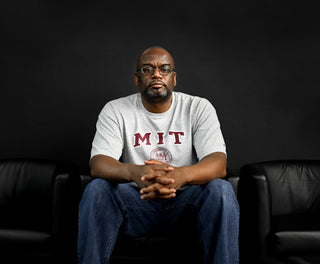D’Wayne Edwards’ story is the stuff of legends. A tale manifested through his love of drawing, made possible through the life of something often overlooked: a No. 2 pencil. The founder of one of the country’s only design academies specializing in footwear, Edwards has made learning and striving for better a habitual process throughout all of his life, yielding success levels unimaginable for a kid growing up in Inglewood, California in the ’80s.
Getting his start at LA Gear in 1989, D’Wayne became the youngest professional footwear designer in the industry at the age of 19, which eventually led to becoming one of only seven people to ever create a signature pair of Air Jordans. As the long-time design director for Brand Jordan, Edwards traveled the world and accomplished the goals and dreams he’d set out to all those years back. Eventually, creating sneakers took a back seat to his love for helping others reach their own aspirations. Inspired by the boom of internet sneaker forums and rise of his own footwear competition initiatives, D’Wayne wanted to give a new generation the tools and access that weren’t available to him as a youth. In 2010, Pensole was birthed, a design academy focused on nurturing young talent and guiding it through a rigorous work process, preparing students for the corporate landscape, and feeding them directly into positions within some of the world’s leading athletic and footwear companies, free of charge.
On a recent trip to Portland, I was invited by the good folks at adidas to visit with D’Wayne and talk about his journey through design, while also getting a first hand feel for Pensole’s latest partnership, a two-week program, Earn Your Stripes, that invited 15 aspiring designers from around the country to Portland on adidas scholarships in search of the new generation of footwear designers. Below D’Wayne Edwards shares his story of triumph in the face of adversity.
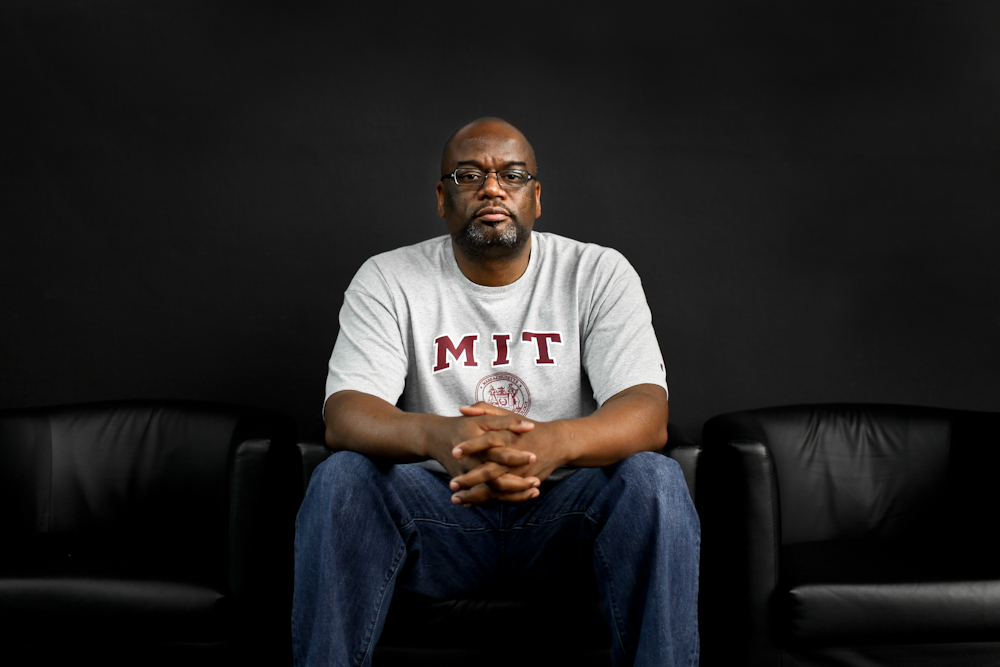
Pensole Design Academy founder D’Wayne Edwards
BECOMING THE YOUNGEST FOOTWEAR DESIGNER IN THE INDUSTRY
Your story about your time at L.A. Gear is fascinating to me. Would you mind sharing it?
I would say it started more when I was at McDonald’s. When I was there I was always drawing sneakers and on my lunch break trying to get another job. I found an ad in the LA Times for a Reebok design contest. So I entered it and ended up winning, but the issue was I was 17 and they weren’t expecting me to show up because the reward was a job. They were like, “Oh, well come back and see us when you finish college.” I was like, “Well, what college should I go to for footwear design?” There were none and even if there were, I wouldn’t have been able to afford to go.
On top of that, when I got back to school, I went back to my guidance counselor like, “I know what I want to do now, I want to be a footwear designer.” They didn’t know, this is Inglewood high ’88, they didn’t know anything about design schools there and I didn’t know that I needed a portfolio to get in, it wasn’t an SAT thing, it was a portfolio piece.
When I started finding some schools, ironically, there was a place called Otis Parsons. Otis and Parsons are now separate, but back then they were together and they were in Downtown LA. So I was looking at that and the cost was crazy – not going to happen. So I graduated and went to Santa Monica Community College and studied business marketing, advertising, and management. I couldn’t get into design school and I wanted to do footwear but there were no schools for that either.
So while I was going to Santa Monica I started working at this accounting company called Accountips. It was me and my best friend from high school and they would just send us out to random jobs. So he was sent on an assignment to go to LA Gear and he said he couldn’t find it, I don’t think he actually went, and the agency got pissed because it was actually his aunt that owned the agency and she sent me the next day; I found it.
So when I got there I was a file clerk in accounts payable, and a few months in they put suggestion boxes in every department. And it was for looking at business ways to make the company better. And because I had been drawing shoes and the shoes weren’t that good I figured I could make it better so I put sketches in the box. So every day for six months I put sketches in the suggestion box; it was the first thing I did when I got in in the morning.
I started working at L.A. Gear in August ’88, right when school started. So I was doing that and six months goes by and the owner of the company –back then they didn’t have email so it was interoffice mail. You’d put a note in an envelope, put it on a desk, someone would pick it up and drop it off somewhere. Then they also had intercom system.
So I get an intercom message, “Hey D’Wayne, come to Robert Greenberg’s office.” I’m like, “Okay, he’s the owner of the company, why?” I would think someone else would fire me, not the owner of the company. So he called me in and had all my sketches and he asked me what school I went to and I was like, “I just graduated from Inglewood high school a couple months ago.” He was like, “Obviously you want to be a designer and I’d like to offer you an entry level design job.” “All right, sweet.” Didn’t negotiate pay or anything, I didn’t even ask and then I found out – I just turned 19 and I was making $18,000 a year; I was straight. Shit, I would’ve paid them.
So that’s how it started and once I got in it was just head down asking questions because I was a sponge; I was right where I wanted to be. And all these people around me had the information I needed and I knew I had options. Either I’d be stubborn and try to figure it out on my own or humble myself and ask questions. All I did was sit there and ask questions. And I did my work, I did more than what they expected me to do because I had to prove myself. Not so much to my other coworkers but more so to Robert Greenberg – who owns Sketchers now by the way. More so to him because I wanted him to know he didn’t make a mistake by taking a chance on me. He didn’t know me, he’s from Boston and moved to LA. But I’ve always had a certain level of appreciation for him taking a chance on me. Even to this day I still feel the same way and I see him every six months at the tradeshows or randomly when I’m in LA and I still have that same feeling of, “You didn’t make a mistake.”
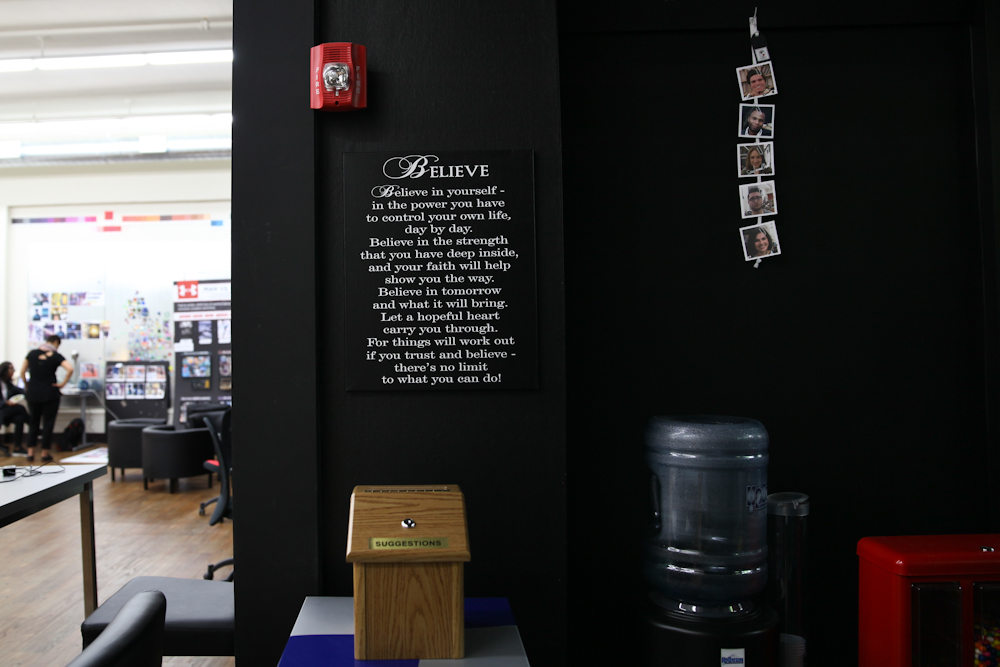
D’Wayne’s suggestions box, a reminder of his beginnings at L.A. Gear
THE DILUTION OF HUMANS & PRODUCT
How different has it been for you, transitioning from a position of designing footwear for a living, to now developing talent that can maybe someday achieve that sort of success on a corporate level?
When you get bigger you have to serve more masters and that’s when the dilution starts to happen. And that’s with any industry. Now that I’m on this side of the table and not on the other side of the table – although, I’m still very familiar with the other side of the table – education’s exactly the same. The difference is people are the product, it’s not a shoe it’s a persona. And that was probably the more troubling thing for me was – in some ways I understand, even when you’re at a product company, it’s an object and you shouldn’t obsess over an object, you should enjoy the object.
But when people become the product and you don’t even treat that right, that troubled me in a lot of ways. To the point where – similar to the product side – the product becomes a dollar amount; it doesn’t even become a product anymore, just a dollar amount on a spreadsheet. Where education starts being the exact same way. Where the student became a line item and a dollar amount. “We need this many students to make this amount of money.”
So because you have to have a certain number of students to continue to exist there’s a natural dilution when that happens. You can look up any business that’s grown big and it’s got diluted on some levels. It just bothered me to think why would we dilute a person? Why would you dilute another human all because of money? Instead of taking a look at your organization and saying, “How can we actually have a better process? How can we spend money more wisely? How can we be smarter about how we do things so you can maintain a certain level of quality?”
I remember when I first started doing this I was speaking to a big school and one of the questions I was asked was, “How big do you want Pensole to be?” I’m like, “I’m not interested in size. People come to this school because they can afford to come here. You don’t have the best students here, just the ones that can afford to be here.” The issue that I have, being on the corporate side, is there are too many people being released into the world thinking that they’re going to be designers and they have no shot. I said, “The industry needs better designers, not more. That’s really what’s missing, there’s a skill set and a personal objective for quality that’s missing that is sad to me.”
From a human perspective that’s not even considered. But, yeah, I’m cool with a certain growth, I know what that is, I’ve worked at three different billion dollar companies so I know what size and volume is, I understand what it does, and that’s not my existence.
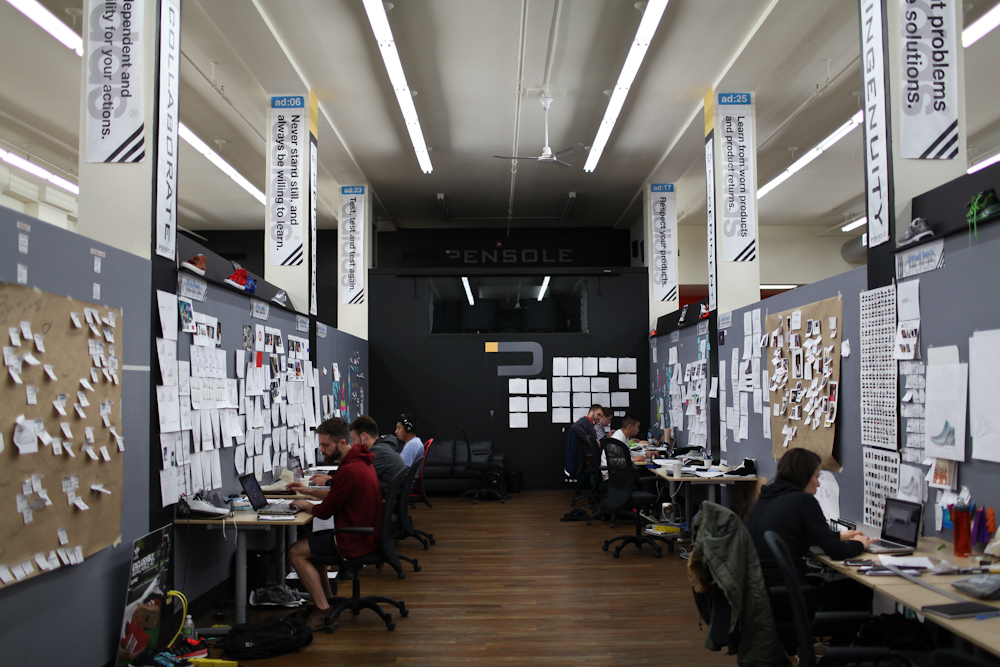
Students from around the country hard at work at Pensole Design Academy
THE DIY GENERATION AND HARD WORK
How different do you think your path would’ve been if everything available now was available back then? Things are so DIY now. How do you think that would’ve changed you as a person?
I wouldn’t be the same person because out of not having I had to make something happen and I had to seek for answers. Now you have Google, I didn’t have Google, I had this thing called the Yellow Pages dude, it was 4 inches thick and you had to decipher if it was under the right alphabet. So I would say that I would be different from a mentality point of view because I had nothing and I’m used to working with nothing.
So to me, having something, I don’t even see it as a privilege. I try to work with minimal, that’s what we do here, work with the minimal tools. But I would say more so with my mindset because there were some things that I discovered along the way. Like, I discovered Jackie Robinson and who he was and his struggle, I discovered the Negro Leagues and how they weren’t allowed to play baseball and they were better than everybody else and they still weren’t allowed to play.
I had to hustle to learn because I didn’t go to school, so I had to find that knowledge from somewhere. Then one of the bigger things is what I learned from Robert [Greenberg] by observation. Robert, he would come in before everybody and he’d read the newspaper and read different footwear publications so he could educate himself every single day.
Founder of L.A. Gear?
Yes, who’s now the owner of Skechers. So what I noticed about him is that he’s at the top and he’s still in before everybody else and staying later than everybody, but he’s educating himself the whole day. So for me that was one of the things I’ve carried from when I first saw him do it everyday. Everyday I start my day with some knowledge, everyday when I start classes I feed them knowledge so they can start the day off right. I’m here before everybody comes in, they stay too late and I got family so I leave [laughs], but I’ve never lost my thirst for being better than what I was yesterday. That’s one of the things that I see is missing today in kids. That level of wanting it like it’s your last breath is not there.
That’s a problem I saw in schools when I was hiring people or visiting; work ethic wasn’t there. But the schools weren’t implementing it either. And when you work in a corporate environment you have to bust your ass and there’s no rewards sometimes. That’s just what you’re supposed to do and that’s one of the things that this is founded on; hard work.
We do more hours in three weeks than you’ll do in a 16 week semester at a regular school. For me, in a corporate environment it’s not start, stop, start, stop, it’s a continuous “go.” You have to get used to that working environment, you have to get used to always being on and that was one of the things I saw kids struggling with. It was, “Okay, you’re going to run a marathon and I’ll give you something to drink when you finish. Not during or before, but after.”
We don’t do any marketing or advertising, but the kids know now if you show up in here you’re going to put in work. You might need to bring a sleeping bag too. These students here are spending three weeks for three minutes, so they have a three minute presentation tomorrow [for Earn Your Stripes]. Three weeks is going to prepare for these three minutes that could totally change your life.
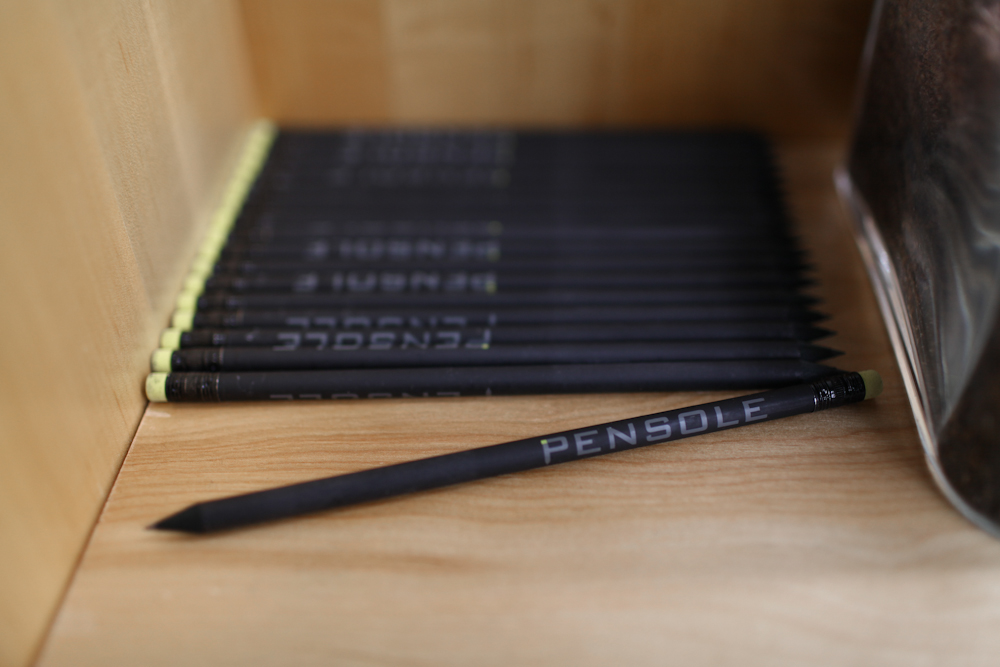
WORKING AT MCDONALD’S
I read that you worked at McDonald’s for a bit as a teenager. Many consider “flipping burgers” a job with no real future. Is there something that you learned there that you didn’t realize until later on in your life? What life lessons did you pull from that experience?
A couple of things actually. I started there when I was 16. One, that was really my first – technically my second job – but people. That was my first time working with people outside of the school, and I wasn’t working with them I was just at school with them. But when you work at a big place, even though it was a restaurant it was a big organization, that was my first introduction to the concept of brand or working for a brand. So I wasn’t just working at this one McDonald’s in Torrance, I was working at this big brand.
For me it was interesting how they expected you to behave a certain way. When you’re at home – I’m the youngest of 6 with a single parent so I knew right from wrong, but when you go from a different environment and there’s a structure that you didn’t have in high school it makes you – you walk in one way and you work, you’re a certain person when you’re there, and then you leave. Where people get it wrong is when they’re the same person when they show up and when they work.
It was my first introduction to, “I am who I am but I need to change according to my environment, I can’t bring Inglewood to Torrance and try to serve people.” I saw other kids around my age do that and I’m like, “You’re not at home, you’re not at school, and you’re not with your boys. You’re in another environment.” So, for me, that was the first one – understanding that there’s a bigger thing called a brand and that you have to adjust to your environments in order to survive in the world.
For me, it wasn’t adjust to my environment to be a different person, it was just like, “Okay, I’m not in the same place so I need to behave the way I should behave.” That actually caught people off guard. Where they weren’t expecting me to act the way I was supposed to. It helped me when I got to L.A. Gear where I was the only black kid there, 19, I wasn’t supposed to be there so people were looking at me sideways and some were resentful because I didn’t go to college. There were little whispers of charity case kid or whatever it may be. I’m like, “All right that’s cool, I’ll take that.”
I took it like, “I’m going to use you for all the information I don’t have because I need it.” One of the things that I learned early, and this was through Jackie Robinson, was you’ll learn more by listening than talking. I noticed, at least with the people I hung around with, they would be seen and talk and when you do that they can see you coming. Rather when you move in silence you can get more done because no one’s seeing you, they can’t hear you, you just show up. They’re like, “Damn, where’d you come from?” “I’ve been here the whole time, you just didn’t see me because I didn’t force you to.” All my boys just wanted to be in the limelight and I’m like, “No, there’s another way.”
A friend of mine, who I look to as a mentor, has always told me, “If you ever go to a big company you want to work for, it’s better to start at the bottom and surprise people, rather than getting a position of —— and having so many expectations of you that you aren’t going to be able to live up to.”
No, that’s true, I had that luxury at L.A. Gear, but when I got to Nike – it was interesting. I was at Skechers before I was a brand manager so I was managing a team in charge of design and they actually put me a step back when I went to Nike, I entered as a senior designer, so the expectations were still high, but they weren’t the same as if I were a design director or manager.
They didn’t utilize my strengths and for me it was cool because I had to adjust. So I was doing ACG (All Conditions Gear). This was in 2000. So one of the first projects was the Nike Goadome stuff. But I also had to work on Trail Hiking shoes and River Sandals – I don’t trail hike or do anything in a river. But it was one of those tests like, “Oh, you’re a city kid so I’m going to give you a flip-flop to do.” But for me I’d take it, I needed the challenge because I needed to show them that I was more dimensional that what they thought I was. That earned their respect.
They knew that I could do the things that they couldn’t do, but when I started doing what they could do, that’s when it became like, “Okay that’s different.”
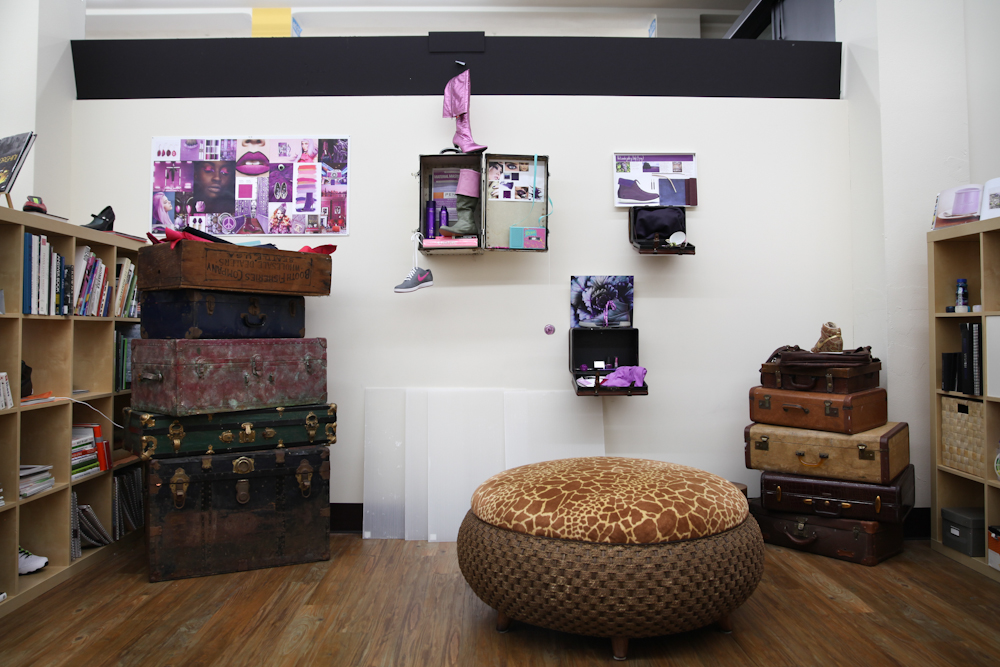
Pensole’s curriculum features a materials lab led by Nike/Jordan veteran and materials guru Suzette Henry
DEVELOPMENT OF THE PENSOLE BRAND
How long did it take you to come up with the name? Was it an “aha!” moment?
A couple things happened. When I started to say, “I’m going to do this thing.” I still wasn’t sure and a friend of mine, Kevin Carroll, who wrote a book called Rules of the Rubber Red Ball, left Nike and wrote this book and he was telling me the story about how Disney didn’t want to pay for the book, they didn’t want to pay for the way he wanted it designed; he had to pay himself. It needed to be a certain visual quality in order for the story to make sense and sink in.
For the first two years when he left I had never read the book and we were friends. One day it was just sitting there and I was like “Oh, let me read it.” So I read the book and the purpose of the book is for you to discover what it is that you’re passionate about. And for him it was a red rubber playground ball because that’s what he did when he was growing up, playing on the playground, and this little playground ball took him all over the world.
I remember after I read the book I wrote him a letter – I still have it on my computer – I wrote him a letter, even though I could’ve called him up, and I was like, “I apologize for just now reading the book. But it helped me understand why I was here.” So Mark Twain has a quote, “There’s two important days in your life. The day you’re born and the day you realize why.”
After I finished reading the book I started to realize that a number two pencil was the reason – not the reason why I’m here – but it’s been my ball and I ignored it. I allowed it to build my life and form what I think; it designed my life. But it became that single instrument that allowed me to leave Inglewood and allowed me to travel the world and do all these amazing things and meet all these amazing people.
When I was thinking about a name for the school I was like, it’s there, sitting right there. So what I do when I design is I always go to the basics. So if I see a word I look it up in the dictionary, even if I know the definition, I still look it up. I looked up the word pencil in the dictionary and the phonetic spelling of how you’re supposed to pronounce it is p-e-n-s-o-l. I was like, “Whoa!” It’s too close to footwear, too close to sole, so I added the “e” in there and it ultimately became a tribute to the instrument that allowed me to do this thing; footwear.
How did your partnership with adidas come about?
I got connected through a guy named Ian Cobb, Ian was a part of a [footwear design competition] program I did at Nike, Future Sole. He actually did not win [Future Sole] but he was one of the finalists and landed a job [with adidas]. So when he got there [adidas] it was simultaneous to when I was transitioning into this [Pensole] and he was telling adidas about it and was like, “You should connect with D’Wayne and maybe we can come in and do some things.” Because he noticed some opportunities for improvement.
So Lucy Nobles (adidas’ design intern program manager) contacts me, this was in 2012, and said, “Okay, let’s try this class and see what we can do because we’re looking to jump start the recruiting process.” Which is what most companies try to do as well. So I would say, honestly, adidas was the first company to figure out what I was doing or what I could do. Which is cast a global net, help you pick which ones you want, and then I’ll train them the way that they need to work at your company and you decide which one you want to work with. It’s as simple as that.
D’Wayne Edwards speaking at TEDxPortland back in May 2014
A NEW CHAPTER
How long did it take you to make the jump from Brand Jordan, which by all accounts was your dream job, to start something that wasn’t guaranteed?
You know, it wasn’t one of those Dave Chappelle moments where you just wake up – “When Keeping it Real Goes Wrong” where you go in and piss on the desk and everything; it wasn’t one of those moments. It was something that had been brewing for a long time and I didn’t act on it. I would say it started to become more real probably ten years ago, roughly. Maybe 11. I started noticing kids putting sketches up on the Internet. Just randomly for feedback, in different forums and stuff. I was like, “Whoa, these kids are just like I was when I was a kid.” I just didn’t have the Internet. [Laughs] So when I started seeing how there were kids out there that wanted to do this thing. I thought, “Wow, wouldn’t it be cool to actually have a place for them to go to actually do it?” So that started it.
Then when I transferred to Jordan, in 2001, I was more visible. At Jordan we’d create products and tell stories, you get to communicate your design to the public. So people started to email me randomly, because you can just put first and last name together and you got @nike.com and you’re good. First dot last name @nike.com.
So I started getting emails of people asking how to get in. In 2007 I started this competition at Nike called Future Sole. And it was based off of my Reebok experience of being in high school and having ability and I told Nike, “I just want to be able to level the playing field for kids.” When we did that, like 800 kids entered the first year, second year it was 10,000, third year we pushed over 100,000 kids into it, fourth year it was close to a million kids.
That whole time I’m working with [Carmelo and Lisa Leslie] and I was like, “I need you to represent from an athlete perspective so kids are still influenced by the athlete piece.” I had to have a hook, so they agreed to be the front people for it so that created the popularity. Then I asked Mel, “Would you mind wearing the shoes in the game?” He was like, “Yeah.” So then we started selling them at East Bay. As a matter of fact the last kid who won in 2011 is over there. And his shoe is over there. So the last kid who won the competition that I did at Nike is sitting in that room over there. He’s a junior at CCS in Detroit, going to school to be a footwear designer.
But when he came to me he was 15. So when I start to see more and more kids wanted to be in footwear and design I was like, “Man, I need to do something about it.” I was trying to hire kids and I couldn’t get a qualified person out of college and I didn’t like what I was seeing from resumes and portfolios. Ultimately, working with people became more satisfying to me than designing. I still love to design, I still love working with the guys that I worked with, but it just didn’t get me up in the morning.
One of the things I told myself when I got into this industry was, “I want to leave it better than when I entered it.” And I didn’t want the product to be what you remembered me by. So when I started this one of the goals I wrote for myself was, “I want you to forget that I ever did that before. That I ever designed shoes, I want you to remember me by this, not by product.”
Not that I’m ashamed of the product, by no means. I just don’t think that that’s what defines who I am as a person and what legacy I want to leave. It’s more than just product.
::
::
Pensole.com
Pensole Academy on Facebook
Pensole Academy on YouTube

